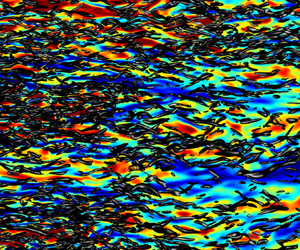Article contents
How spanwise travelling transversal surface waves change the near-wall flow
Published online by Cambridge University Press: 23 February 2023
Abstract

The alteration of the near-wall flow field of a turbulent boundary layer flow subjected to spanwise travelling transversal surface waves at a friction Reynolds number  $Re_\tau \approx 1525$ is investigated. The results of a spatial noise-assisted multivariate empirical mode decomposition reveal that this flow control method periodically induces near-wall large-scale bursts while simultaneously lowering the energetic content of small-scale features. The increasing occurrence of intense large-scale ejections in the near-wall region is of particular importance for reducing the wall-shear stress since these ejections balance large-scale sweeps originating from the outer layer. Thus, they corrupt the outer-layer impact on the near-wall dynamics and, consequently, the overall fluctuation intensity at the wall is attenuated. This disturbed top-down momentum exchange is highlighted by an inner–outer interaction analysis, which further reveals an increased bottom-up communication provoked by the large-scale ejections. Moreover, it is shown that the periodic secondary flow field induced by the actuation interferes with the quasi-streamwise vortices in the near-wall region. The velocity gradients of the secondary flow field deform the vortices’ cross-section into an elliptic shape, which yields an unstable vortex state resulting in vortex disintegration. In combination with the effect of the large-scale ejections, the reduced number of quasi-streamwise vortices compared with the undisturbed boundary layer flow results in a decreased wall-normal momentum exchange and the widening and weakening of near-wall streaks. This yields a reduced fluctuation intensity in the near-wall region that lowers the overall wall-shear stress level.
$Re_\tau \approx 1525$ is investigated. The results of a spatial noise-assisted multivariate empirical mode decomposition reveal that this flow control method periodically induces near-wall large-scale bursts while simultaneously lowering the energetic content of small-scale features. The increasing occurrence of intense large-scale ejections in the near-wall region is of particular importance for reducing the wall-shear stress since these ejections balance large-scale sweeps originating from the outer layer. Thus, they corrupt the outer-layer impact on the near-wall dynamics and, consequently, the overall fluctuation intensity at the wall is attenuated. This disturbed top-down momentum exchange is highlighted by an inner–outer interaction analysis, which further reveals an increased bottom-up communication provoked by the large-scale ejections. Moreover, it is shown that the periodic secondary flow field induced by the actuation interferes with the quasi-streamwise vortices in the near-wall region. The velocity gradients of the secondary flow field deform the vortices’ cross-section into an elliptic shape, which yields an unstable vortex state resulting in vortex disintegration. In combination with the effect of the large-scale ejections, the reduced number of quasi-streamwise vortices compared with the undisturbed boundary layer flow results in a decreased wall-normal momentum exchange and the widening and weakening of near-wall streaks. This yields a reduced fluctuation intensity in the near-wall region that lowers the overall wall-shear stress level.
Information
- Type
- JFM Papers
- Information
- Copyright
- © The Author(s), 2023. Published by Cambridge University Press
References
- 11
- Cited by


